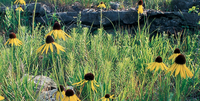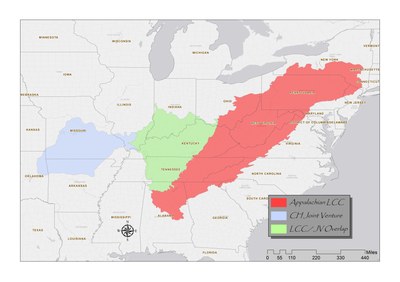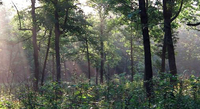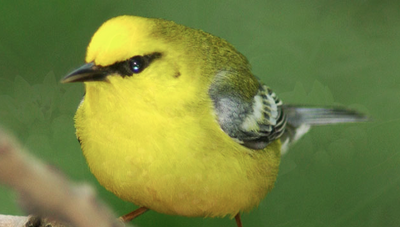Central Hardwoods Joint Venture
|
The Central Hardwoods Joint Venture (CHJV) is a partnership of state and federal government agencies and non-governmental organizations who work together to ensure the long-term viability of native bird populations. CHJV concentrates conservation efforts over an area comprising 75 million acres of rolling hills covered with hardwood forests interspersed with glades and woodlands and crisscrossed by deep river valleys. The area includes the Ozark Highlands, Boston Mountains, and Interior Lowland Plateaus. To protect native bird species throughout their ranges, the JV works with partners in Mexico and Canada in areas that these birds use for breeding or over-wintering. |
|
CHJV and the Appalachian LCCThe Appalachian LCC funds research of the conservation community’s top science needs to address the landscape conservation challenges within the region. By identifying, prioritizing, and supporting fundamental scientific research through coordination and strategic investment of scarce resources, the Appalachian LCC is fostering the development and application of vital information and decision-support tools. As a bird partnership working to insure the long-term viability of native bird populations across the Central Hardwoods region, the CHJV uses their own science as well as research supported by the Appalachian LCC for delivering on-the-ground conservation activities and projects to protect a diversity of habitats to sustain migratory bird populations for the benefit of those species, other wildlife, and the public. Projects
1. Regional Glade Conservation Assessment This collaborative effort analyzed and documented the current status and distribution of glade ecosystems within the Central Hardwoods Bird Conservation Region planning area and was completed in 2013. This assessment is the first step in identifying glade complexes with the greatest potential to address the habitat needs of numerous species of conservation concern associated with these shallow bedrock communities. 2. Interior Highland Shortleaf Pine Initiative In 2011 the CHJV formed a regional partnership with the goal of sharing knowledge about the restoration and management of shortleaf or pine-oak ecosystems across the Ozark, Boston, and Ouachita Mountains. To date, there are roughly 500,000 acres of ecosystem restoration targeted in key landscapes on public lands alone, with large amounts of funding coming from the U.S.D.A. Forest Service’s Collaborative Forest Landscape Restoration Program. It is anticipated that this effort will become part of a range wide Shortleaf Pine restoration project in the future. 3. Promotion of Prescribed Fire The CHJV is actively engaged in supporting prescribed fire use at not only the regional, but also the national level, and is a participating member of state prescribed fire councils in Missouri, Kentucky, Arkansas and Tennessee. We also work closely with the Oaks and Forest Fire Consortium, the National Bobwhite Conservation Initiative’s Forestry Subcommittee and other organizations to maintain fire as a viable management tool. Click here to learn more about each project and other Partnership efforts... CHJV and Appalachian LCC BoundariesThis map details the boundaries of the Central Hardwood Joint Venture and the Appalachian LCC, detailing where the two partnerships areas of research and management overlap. |
Implementation
Natural Community Restoration Natural communities are important to bird conservation in the Central Hardwoods Bird Conservation Region. Numerous studies have shown that as native grasslands, open woodland and riparian habitats have declined, so have the avian species that use them. Though artificial plantings, managed old fields, and forest manipulations can provide temporary habitat for these species, natural habitat communities such as glades, open woodlands, savannas, and barrens provide a much more diverse, persistent, and resilient environment for many declining bird species. Strategic restoration and proper management of these critical habitats will be vital to reversing the downward trends of many grassland and shrub land birds. Linking Populations to Habitat
Forest Bird Assessment Project: This project focused on estimating densities of six forest interior species. Partners from five states helped perform point count surveys in highly forested areas and data were analyzed using time-removal and distance models to account for imperfect detectability. Savanna/Woodland Assessment Project: This project focused on estimating densities of open woodland and interior forest birds in restored sites versus unmanaged sites. Partners from three states helped perform point count surveys. Data are currently being analyzed. HSI Model Assessment Project: This new project is using data from the previous assessment projects, along with supplemental cooperative surveys in 2009 and other point count data from within the CHBCR as available. The primary goal of this project is to develop linkages between HSI model estimates and observed densities in order to produce better habitat objectives (i.e. how much habitat is needed to sustain populations at goal). Further the project will help refine and improve the HSI models for use in site & landscape-scale planning. Grassland Bird Monitoring Project: Conservation planning requires information on bird distribution and habitat associations. The CHJV staff is working with cooperators at the University of Tennessee to generate this much-needed information for grassland birds. This project uses roadside counts and distance sampling to link bird densities to site-scale (e.g., adjacent cover types) & county-level (e.g., acres of grass) measures of habitat composition. It is supported by the USDA Natural Resources Conservation Service’s Conservation Easement Affects Project and CHJV partner agencies. The project collected field data from across the CHBCR during 2008-2012. Results from this project will serve as the basis for grassland bird conservation planning in the CHJV. |


 Though some projects are directly linked to habitat improvements, many focus on directing and facilitating cooperation between partners, influencing policies and agency operations, or providing information and support to our partners. Most of the effort is focused within the CHBCR, but the CHJV will engage in national, regional and even international projects which benefit our habitat and population goals. The following are some of the most recent efforts;
Though some projects are directly linked to habitat improvements, many focus on directing and facilitating cooperation between partners, influencing policies and agency operations, or providing information and support to our partners. Most of the effort is focused within the CHBCR, but the CHJV will engage in national, regional and even international projects which benefit our habitat and population goals. The following are some of the most recent efforts;
 Studies and research in bird conservation are important, but to make a difference for priority bird populations, our knowledge and the tools we have developed must be applied to the landscape. The CHJV works with partners to ensure policy makers, land managers, and other resource professionals receive the best information and technologies. By influencing policies, directing management priorities, and providing up to date information to state and federal agencies and non-government organizations, the CHJV keeps priority bird conservation efforts integrated into management efforts on both public and private land.
Studies and research in bird conservation are important, but to make a difference for priority bird populations, our knowledge and the tools we have developed must be applied to the landscape. The CHJV works with partners to ensure policy makers, land managers, and other resource professionals receive the best information and technologies. By influencing policies, directing management priorities, and providing up to date information to state and federal agencies and non-government organizations, the CHJV keeps priority bird conservation efforts integrated into management efforts on both public and private land. In order to estimate the habitat needed to support our population objectives through time (i.e., habitat objectives), we must link habitat conditions to population response. Because our population objectives for woodland and forest birds are currently stated in terms of abundance, we must link habitat conditions to density (# individuals per unit area). Doing so will allow us to scale density to outputs of the
In order to estimate the habitat needed to support our population objectives through time (i.e., habitat objectives), we must link habitat conditions to population response. Because our population objectives for woodland and forest birds are currently stated in terms of abundance, we must link habitat conditions to density (# individuals per unit area). Doing so will allow us to scale density to outputs of the 



















